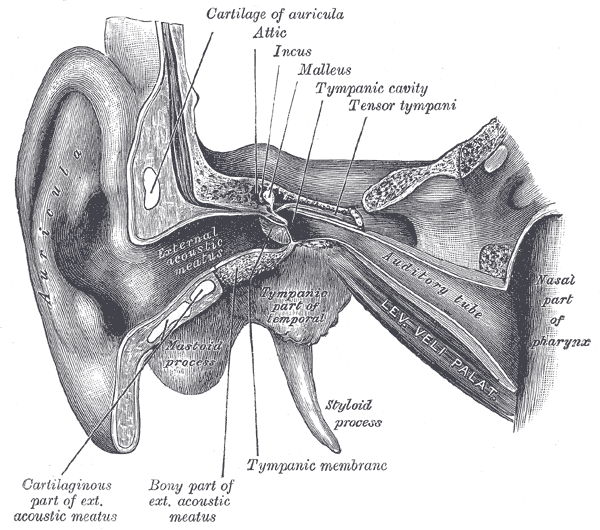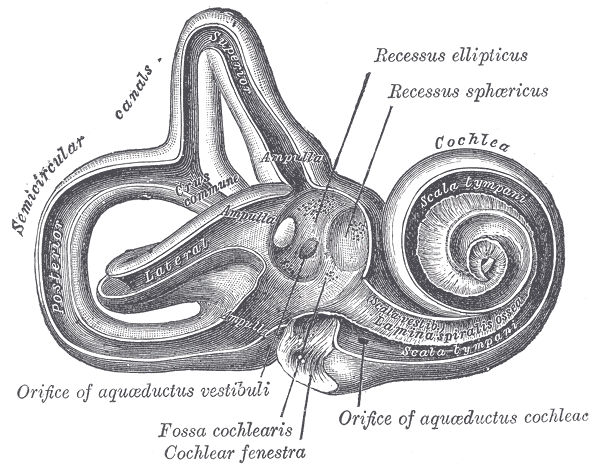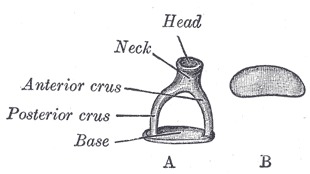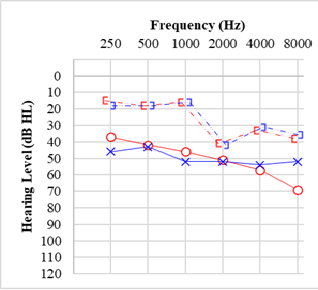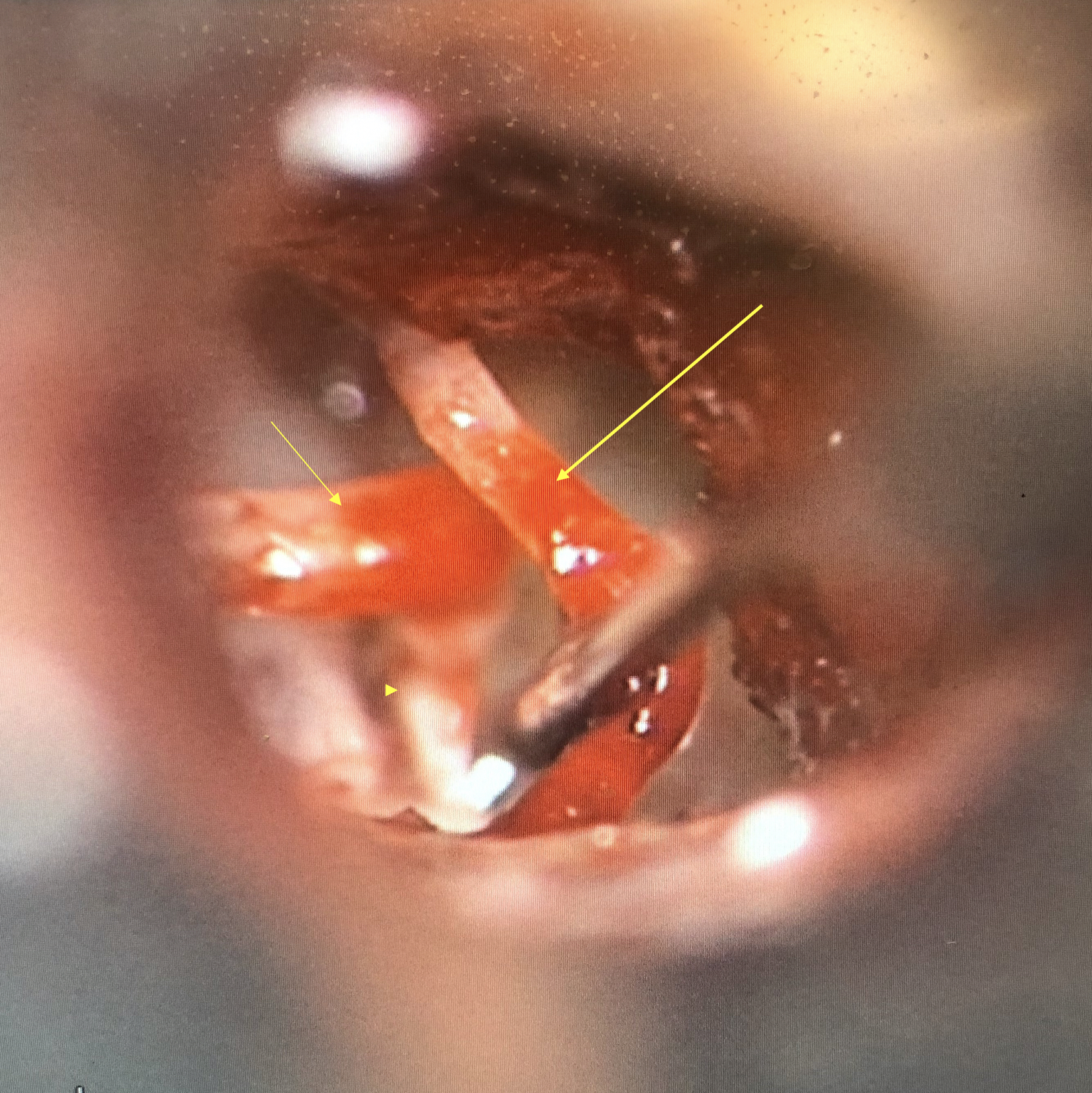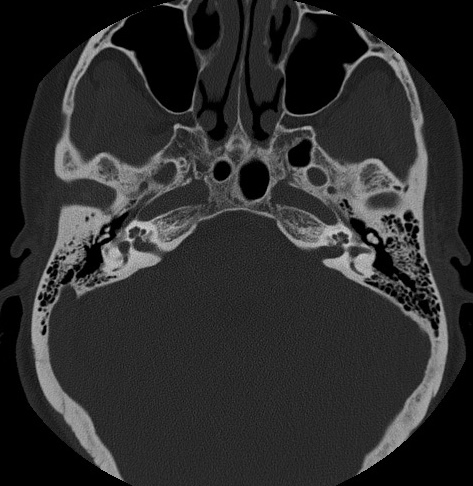[1]
Makarem AO, Hoang TA, Lo WW, Linthicum FH Jr, Fayad JN. Cavitating otosclerosis: clinical, radiologic, and histopathologic correlations. Otology & neurotology : official publication of the American Otological Society, American Neurotology Society [and] European Academy of Otology and Neurotology. 2010 Apr:31(3):381-4. doi: 10.1097/MAO.0b013e3181d275e8. Epub
[PubMed PMID: 20195188]
[2]
Rudic M, Keogh I, Wagner R, Wilkinson E, Kiros N, Ferrary E, Sterkers O, Bozorg Grayeli A, Zarkovic K, Zarkovic N. The pathophysiology of otosclerosis: Review of current research. Hearing research. 2015 Dec:330(Pt A):51-6. doi: 10.1016/j.heares.2015.07.014. Epub 2015 Aug 12
[PubMed PMID: 26276418]
[4]
Bittermann AJ, Wegner I, Noordman BJ, Vincent R, van der Heijden GJ, Grolman W. An introduction of genetics in otosclerosis: a systematic review. Otolaryngology--head and neck surgery : official journal of American Academy of Otolaryngology-Head and Neck Surgery. 2014 Jan:150(1):34-9. doi: 10.1177/0194599813509951. Epub 2013 Oct 29
[PubMed PMID: 24170657]
Level 1 (high-level) evidence
[5]
Van Den Bogaert K, Govaerts PJ, Schatteman I, Brown MR, Caethoven G, Offeciers FE, Somers T, Declau F, Coucke P, Van de Heyning P, Smith RJ, Van Camp G. A second gene for otosclerosis, OTSC2, maps to chromosome 7q34-36. American journal of human genetics. 2001 Feb:68(2):495-500
[PubMed PMID: 11170898]
[6]
Chen W, Campbell CA, Green GE, Van Den Bogaert K, Komodikis C, Manolidis LS, Aconomou E, Kyamides Y, Christodoulou K, Faghel C, Giguére CM, Alford RL, Manolidis S, Van Camp G, Smith RJ. Linkage of otosclerosis to a third locus (OTSC3) on human chromosome 6p21.3-22.3. Journal of medical genetics. 2002 Jul:39(7):473-7
[PubMed PMID: 12114476]
[7]
Brownstein Z, Goldfarb A, Levi H, Frydman M, Avraham KB. Chromosomal mapping and phenotypic characterization of hereditary otosclerosis linked to the OTSC4 locus. Archives of otolaryngology--head & neck surgery. 2006 Apr:132(4):416-24
[PubMed PMID: 16618911]
[8]
Thys M, Van Den Bogaert K, Iliadou V, Vanderstraeten K, Dieltjens N, Schrauwen I, Chen W, Eleftheriades N, Grigoriadou M, Pauw RJ, Cremers CR, Smith RJ, Petersen MB, Van Camp G. A seventh locus for otosclerosis, OTSC7, maps to chromosome 6q13-16.1. European journal of human genetics : EJHG. 2007 Mar:15(3):362-8
[PubMed PMID: 17213839]
[9]
Bel Hadj Ali I, Thys M, Beltaief N, Schrauwen I, Hilgert N, Vanderstraeten K, Dieltjens N, Mnif E, Hachicha S, Besbes G, Ben Arab S, Van Camp G. A new locus for otosclerosis, OTSC8, maps to the pericentromeric region of chromosome 9. Human genetics. 2008 Apr:123(3):267-72. doi: 10.1007/s00439-008-0470-3. Epub 2008 Jan 26
[PubMed PMID: 18224337]
[10]
Schrauwen I, Weegerink NJ, Fransen E, Claes C, Pennings RJ, Cremers CW, Huygen PL, Kunst HP, Van Camp G. A new locus for otosclerosis, OTSC10, maps to chromosome 1q41-44. Clinical genetics. 2011 May:79(5):495-7. doi: 10.1111/j.1399-0004.2010.01576.x. Epub
[PubMed PMID: 21470211]
[11]
Chen W, Meyer NC, McKenna MJ, Pfister M, McBride DJ Jr, Fukushima K, Thys M, Camp GV, Smith RJ. Single-nucleotide polymorphisms in the COL1A1 regulatory regions are associated with otosclerosis. Clinical genetics. 2007 May:71(5):406-14
[PubMed PMID: 17489845]
[12]
Thys M, Schrauwen I, Vanderstraeten K, Dieltjens N, Fransen E, Ealy M, Cremers CW, van de Heyning P, Vincent R, Offeciers E, Smith RH, van Camp G. Detection of rare nonsynonymous variants in TGFB1 in otosclerosis patients. Annals of human genetics. 2009 Mar:73(2):171-5. doi: 10.1111/j.1469-1809.2009.00505.x. Epub 2009 Jan 30
[PubMed PMID: 19207109]
[13]
Imauchi Y, Jeunemaître X, Boussion M, Ferrary E, Sterkers O, Grayeli AB. Relation between renin-angiotensin-aldosterone system and otosclerosis: a genetic association and in vitro study. Otology & neurotology : official publication of the American Otological Society, American Neurotology Society [and] European Academy of Otology and Neurotology. 2008 Apr:29(3):295-301
[PubMed PMID: 18491423]
[14]
Yoo TJ. Etiopathogenesis of otosclerosis: a hypothesis. The Annals of otology, rhinology, and laryngology. 1984 Jan-Feb:93(1 Pt 1):28-33
[PubMed PMID: 6367600]
[15]
Miyazawa T, Tago C, Ueda H, Niwa H, Yanagita N. HLA associations in otosclerosis in Japanese patients. European archives of oto-rhino-laryngology : official journal of the European Federation of Oto-Rhino-Laryngological Societies (EUFOS) : affiliated with the German Society for Oto-Rhino-Laryngology - Head and Neck Surgery. 1996:253(8):501-3
[PubMed PMID: 8950552]
[16]
Karosi T, Jókay I, Kónya J, Szabó LZ, Pytel J, Jóri J, Szalmás A, Sziklai I. Detection of osteoprotegerin and TNF-alpha mRNA in ankylotic Stapes footplates in connection with measles virus positivity. The Laryngoscope. 2006 Aug:116(8):1427-33
[PubMed PMID: 16885748]
Level 2 (mid-level) evidence
[17]
Menger DJ, Tange RA. The aetiology of otosclerosis: a review of the literature. Clinical otolaryngology and allied sciences. 2003 Apr:28(2):112-20
[PubMed PMID: 12680829]
[18]
Fanó G, Venti-Donti G, Belia S, Paludetti G, Antonica A, Donti E, Maurizi M. PTH induces modification of transductive events in otosclerotic bone cell cultures. Cell biochemistry and function. 1993 Dec:11(4):257-61
[PubMed PMID: 8275550]
[19]
Markou K, Goudakos J. An overview of the etiology of otosclerosis. European archives of oto-rhino-laryngology : official journal of the European Federation of Oto-Rhino-Laryngological Societies (EUFOS) : affiliated with the German Society for Oto-Rhino-Laryngology - Head and Neck Surgery. 2009 Jan:266(1):25-35. doi: 10.1007/s00405-008-0790-x. Epub 2008 Aug 13
[PubMed PMID: 18704474]
Level 3 (low-level) evidence
[20]
Crompton M, Cadge BA, Ziff JL, Mowat AJ, Nash R, Lavy JA, Powell HRF, Aldren CP, Saeed SR, Dawson SJ. The Epidemiology of Otosclerosis in a British Cohort. Otology & neurotology : official publication of the American Otological Society, American Neurotology Society [and] European Academy of Otology and Neurotology. 2019 Jan:40(1):22-30. doi: 10.1097/MAO.0000000000002047. Epub
[PubMed PMID: 30540696]
[21]
Moumoulidis I, Axon P, Baguley D, Reid E. A review on the genetics of otosclerosis. Clinical otolaryngology : official journal of ENT-UK ; official journal of Netherlands Society for Oto-Rhino-Laryngology & Cervico-Facial Surgery. 2007 Aug:32(4):239-47
[PubMed PMID: 17651264]
[22]
Morrison AW, Bundey SE. The inheritance of otosclerosis. The Journal of laryngology and otology. 1970 Sep:84(9):921-32
[PubMed PMID: 5471896]
[23]
Ben Arab S, Besbes G, Hachicha S. [Otosclerosis in populations living in northern Tunisia: epidemiology and etiology]. Annales d'oto-laryngologie et de chirurgie cervico faciale : bulletin de la Societe d'oto-laryngologie des hopitaux de Paris. 2001 Feb:118(1):19-25
[PubMed PMID: 11240433]
[24]
Ricci G, Gambacorta V, Lapenna R, Della Volpe A, La Mantia I, Ralli M, Di Stadio A. The effect of female hormone in otosclerosis. A comparative study and speculation about their effect on the ossicular chain based on the clinical results. European archives of oto-rhino-laryngology : official journal of the European Federation of Oto-Rhino-Laryngological Societies (EUFOS) : affiliated with the German Society for Oto-Rhino-Laryngology - Head and Neck Surgery. 2022 Oct:279(10):4831-4838. doi: 10.1007/s00405-022-07295-w. Epub 2022 Feb 21
[PubMed PMID: 35187596]
Level 2 (mid-level) evidence
[25]
JOSEPH RB, FRAZER JP. OTOSCLEROSIS INCIDENCE IN CAUCASIANS AND JAPANESE. Archives of otolaryngology (Chicago, Ill. : 1960). 1964 Sep:80():256-62
[PubMed PMID: 14172803]
[26]
Arli C, Gulmez I, Saraç ET, Okuyucu Ş. Assessment of inflammatory markers in otosclerosis patients. Brazilian journal of otorhinolaryngology. 2020 Jul-Aug:86(4):456-460. doi: 10.1016/j.bjorl.2018.12.014. Epub 2019 Mar 8
[PubMed PMID: 30926454]
[27]
Gristwood RE, Venables WN. Pregnancy and otosclerosis. Clinical otolaryngology and allied sciences. 1983 Jun:8(3):205-10
[PubMed PMID: 6883784]
[28]
Karosi T, Kónya J, Szabó LZ, Sziklai I. Measles virus prevalence in otosclerotic foci. Advances in oto-rhino-laryngology. 2007:65():93-106. doi: 10.1159/000098677. Epub
[PubMed PMID: 17245029]
Level 3 (low-level) evidence
[29]
Karosi T, Jókay I, Kónya J, Petkó M, Szabó LZ, Pytel J, Jóri J, Sziklai I. Activated osteoclasts with CD51/61 expression in otosclerosis. The Laryngoscope. 2006 Aug:116(8):1478-84
[PubMed PMID: 16885757]
[30]
Niedermeyer HP, Arnold W, Schuster M, Baumann C, Kramer J, Neubert WJ, Sedlmeier R. Persistent measles virus infection and otosclerosis. The Annals of otology, rhinology, and laryngology. 2001 Oct:110(10):897-903
[PubMed PMID: 11642419]
[31]
Niedermeyer HP, Arnold W, Neubert WJ, Sedlmeier R. Persistent measles virus infection as a possible cause of otosclerosis: state of the art. Ear, nose, & throat journal. 2000 Aug:79(8):552-4, 556, 558 passim
[PubMed PMID: 10969462]
[32]
Niedermeyer HP, Arnold W. Otosclerosis: a measles virus associated inflammatory disease. Acta oto-laryngologica. 1995 Mar:115(2):300-3
[PubMed PMID: 7610826]
[33]
McKenna MJ, Kristiansen AG, Haines J. Polymerase chain reaction amplification of a measles virus sequence from human temporal bone sections with active otosclerosis. The American journal of otology. 1996 Nov:17(6):827-30
[PubMed PMID: 8915408]
[34]
McKenna MJ, Mills BG. Immunohistochemical evidence of measles virus antigens in active otosclerosis. Otolaryngology--head and neck surgery : official journal of American Academy of Otolaryngology-Head and Neck Surgery. 1989 Oct:101(4):415-21
[PubMed PMID: 2508016]
[35]
Arnold W, Friedmann I. [Detection of measles and rubella-specific antigens in the endochondral ossification zone in otosclerosis]. Laryngologie, Rhinologie, Otologie. 1987 Apr:66(4):167-71
[PubMed PMID: 2439859]
[36]
Arnold W, Niedermeyer HP, Lehn N, Neubert W, Höfler H. Measles virus in otosclerosis and the specific immune response of the inner ear. Acta oto-laryngologica. 1996 Sep:116(5):705-9
[PubMed PMID: 8908246]
[37]
Arnold W, Busch R, Arnold A, Ritscher B, Neiss A, Niedermeyer HP. The influence of measles vaccination on the incidence of otosclerosis in Germany. European archives of oto-rhino-laryngology : official journal of the European Federation of Oto-Rhino-Laryngological Societies (EUFOS) : affiliated with the German Society for Oto-Rhino-Laryngology - Head and Neck Surgery. 2007 Jul:264(7):741-8
[PubMed PMID: 17297608]
[38]
Horner KC. The effect of sex hormones on bone metabolism of the otic capsule--an overview. Hearing research. 2009 Jun:252(1-2):56-60. doi: 10.1016/j.heares.2008.12.004. Epub 2008 Dec 24
[PubMed PMID: 19121641]
Level 3 (low-level) evidence
[39]
Browning GG, Gatehouse S. Sensorineural hearing loss in stapedial otosclerosis. The Annals of otology, rhinology, and laryngology. 1984 Jan-Feb:93(1 Pt 1):13-16
[PubMed PMID: 6703592]
[40]
Declau F, Spaendonck MV, Timmermans JP, Michaels L, Liang J, Qiu JP, Van de Heyning P. Prevalence of histologic otosclerosis: an unbiased temporal bone study in Caucasians. Advances in oto-rhino-laryngology. 2007:65():6-16. doi: 10.1159/000098663. Epub
[PubMed PMID: 17245017]
Level 2 (mid-level) evidence
[42]
Sagar PR, Shah P, Bollampally VC, Alhumaidi N, Malik BH. Otosclerosis and Measles: Do Measles Have a Role in Otosclerosis? A Review Article. Cureus. 2020 Aug 21:12(8):e9908. doi: 10.7759/cureus.9908. Epub 2020 Aug 21
[PubMed PMID: 32968571]
[43]
Chole RA, McKenna M. Pathophysiology of otosclerosis. Otology & neurotology : official publication of the American Otological Society, American Neurotology Society [and] European Academy of Otology and Neurotology. 2001 Mar:22(2):249-57
[PubMed PMID: 11300278]
[44]
Wiatr A, Składzień J, Świeży K, Wiatr M. A Biochemical Analysis of the Stapes. Medical science monitor : international medical journal of experimental and clinical research. 2019 Apr 12:25():2679-2686. doi: 10.12659/MSM.913635. Epub 2019 Apr 12
[PubMed PMID: 30975972]
[45]
Viza Puiggrós I, Granell Moreno E, Calvo Navarro C, Bohé Rovira M, Orús Dotu C, Quer I Agustí M. Diagnostic utility of labyrinth capsule bone density in the diagnosis of otosclerosis with high resolution tomography. Acta otorrinolaringologica espanola. 2020 Jul-Aug:71(4):242-248. doi: 10.1016/j.otorri.2019.09.004. Epub 2020 Mar 8
[PubMed PMID: 32156439]
[46]
Lindsay JR. Blue mantles in otosclerosis. The Annals of otology, rhinology, and laryngology. 1974 Jan-Feb:83(1):33-41
[PubMed PMID: 4130014]
[47]
Quinn KJ, Coelho DH. The Curious Rise and Incomplete Fall of "Paracusis Willisii". Otology & neurotology : official publication of the American Otological Society, American Neurotology Society [and] European Academy of Otology and Neurotology. 2022 Jan 1:43(1):137-143. doi: 10.1097/MAO.0000000000003368. Epub
[PubMed PMID: 34619730]
[48]
Eza-Nuñez P, Manrique-Rodriguez M, Perez-Fernandez N. Otosclerosis among patients with dizziness. Revue de laryngologie - otologie - rhinologie. 2010:131(3):199-206
[PubMed PMID: 21488576]
[49]
Uppal S, Bajaj Y, Rustom I, Coatesworth AP. Otosclerosis 1: the aetiopathogenesis of otosclerosis. International journal of clinical practice. 2009 Oct:63(10):1526-30. doi: 10.1111/j.1742-1241.2009.02045.x. Epub
[PubMed PMID: 19769709]
[50]
Nourollahian M, Irani S. Bilateral schwartze sign, decision-making for surgery. Iranian journal of otorhinolaryngology. 2013 Sep:25(73):263
[PubMed PMID: 24303451]
[51]
Salomone R, Riskalla PE, Vicente Ade O, Boccalini MC, Chaves AG, Lopes R, Felin Filho GB. Pediatric otosclerosis: case report and literature review. Brazilian journal of otorhinolaryngology. 2008 Mar-Apr:74(2):303-6
[PubMed PMID: 18568213]
Level 3 (low-level) evidence
[52]
Kelly EA, Li B, Adams ME. Diagnostic Accuracy of Tuning Fork Tests for Hearing Loss: A Systematic Review. Otolaryngology--head and neck surgery : official journal of American Academy of Otolaryngology-Head and Neck Surgery. 2018 Aug:159(2):220-230. doi: 10.1177/0194599818770405. Epub 2018 Apr 17
[PubMed PMID: 29661046]
Level 1 (high-level) evidence
[54]
Kashio A, Ito K, Kakigi A, Karino S, Iwasaki S, Sakamoto T, Yasui T, Suzuki M, Yamasoba T. Carhart notch 2-kHz bone conduction threshold dip: a nondefinitive predictor of stapes fixation in conductive hearing loss with normal tympanic membrane. Archives of otolaryngology--head & neck surgery. 2011 Mar:137(3):236-40. doi: 10.1001/archoto.2011.14. Epub
[PubMed PMID: 21422306]
[55]
Cureoglu S, Baylan MY, Paparella MM. Cochlear otosclerosis. Current opinion in otolaryngology & head and neck surgery. 2010 Oct:18(5):357-62. doi: 10.1097/MOO.0b013e32833d11d9. Epub
[PubMed PMID: 20693902]
Level 3 (low-level) evidence
[56]
Keefe DH, Archer KL, Schmid KK, Fitzpatrick DF, Feeney MP, Hunter LL. Identifying Otosclerosis with Aural Acoustical Tests of Absorbance, Group Delay, Acoustic Reflex Threshold, and Otoacoustic Emissions. Journal of the American Academy of Audiology. 2017 Oct:28(9):838-860. doi: 10.3766/jaaa.16172. Epub
[PubMed PMID: 28972472]
[57]
Terkildsen K, Osterhammel P, Bretlau P. Acoustic middle ear muscle reflexes in patients with otosclerosis. Archives of otolaryngology (Chicago, Ill. : 1960). 1973 Sep:98(3):152-5
[PubMed PMID: 4742419]
[58]
Virk JS, Singh A, Lingam RK. The role of imaging in the diagnosis and management of otosclerosis. Otology & neurotology : official publication of the American Otological Society, American Neurotology Society [and] European Academy of Otology and Neurotology. 2013 Sep:34(7):e55-60. doi: 10.1097/MAO.0b013e318298ac96. Epub
[PubMed PMID: 23921926]
[59]
de Oliveira Penido N, de Oliveira Vicente A. Medical Management of Otosclerosis. Otolaryngologic clinics of North America. 2018 Apr:51(2):441-452. doi: 10.1016/j.otc.2017.11.006. Epub
[PubMed PMID: 29502728]
[60]
Lee TC, Aviv RI, Chen JM, Nedzelski JM, Fox AJ, Symons SP. CT grading of otosclerosis. AJNR. American journal of neuroradiology. 2009 Aug:30(7):1435-9. doi: 10.3174/ajnr.A1558. Epub 2009 Mar 25
[PubMed PMID: 19321627]
[61]
Uppal S, Bajaj Y, Coatesworth AP. Otosclerosis 2: the medical management of otosclerosis. International journal of clinical practice. 2010 Jan:64(2):256-65. doi: 10.1111/j.1742-1241.2009.02046.x. Epub
[PubMed PMID: 20089010]
[62]
Hentschel MA, Huizinga P, van der Velden DL, Wegner I, Bittermann AJ, van der Heijden GJ, Grolman W. Limited evidence for the effect of sodium fluoride on deterioration of hearing loss in patients with otosclerosis: a systematic review of the literature. Otology & neurotology : official publication of the American Otological Society, American Neurotology Society [and] European Academy of Otology and Neurotology. 2014 Jul:35(6):1052-7. doi: 10.1097/MAO.0000000000000310. Epub
[PubMed PMID: 24751746]
Level 3 (low-level) evidence
[63]
Quesnel AM, Seton M, Merchant SN, Halpin C, McKenna MJ. Third-generation bisphosphonates for treatment of sensorineural hearing loss in otosclerosis. Otology & neurotology : official publication of the American Otological Society, American Neurotology Society [and] European Academy of Otology and Neurotology. 2012 Oct:33(8):1308-14. doi: 10.1097/MAO.0b013e318268d1b3. Epub
[PubMed PMID: 22935809]
[64]
Gogoulos PP, Sideris G, Nikolopoulos T, Sevastatou EK, Korres G, Delides A. Conservative Otosclerosis Treatment With Sodium Fluoride and Other Modern Formulations: A Systematic Review. Cureus. 2023 Feb:15(2):e34850. doi: 10.7759/cureus.34850. Epub 2023 Feb 10
[PubMed PMID: 36923175]
Level 1 (high-level) evidence
[66]
Cheng HCS,Agrawal SK,Parnes LS, Stapedectomy Versus Stapedotomy. Otolaryngologic clinics of North America. 2018 Apr;
[PubMed PMID: 29397948]
[67]
Bajaj Y, Uppal S, Bhatti I, Coatesworth AP. Otosclerosis 3: the surgical management of otosclerosis. International journal of clinical practice. 2010 Mar:64(4):505-10. doi: 10.1111/j.1742-1241.2009.02047.x. Epub
[PubMed PMID: 20456195]
[68]
McElveen JT Jr, Kutz JW Jr. Controversies in the Evaluation and Management of Otosclerosis. Otolaryngologic clinics of North America. 2018 Apr:51(2):487-499. doi: 10.1016/j.otc.2017.11.017. Epub
[PubMed PMID: 29502731]
[69]
Redfors YD, Hellgren J, Möller C. Hearing-aid use and benefit: a long-term follow-up in patients undergoing surgery for otosclerosis. International journal of audiology. 2013 Mar:52(3):194-9. doi: 10.3109/14992027.2012.754957. Epub 2013 Jan 22
[PubMed PMID: 23336672]
[70]
Mahadevaiah A, Parikh B, Kumaraswamy K. Reparative granuloma following stapes surgery. Indian journal of otolaryngology and head and neck surgery : official publication of the Association of Otolaryngologists of India. 2007 Dec:59(4):346-8. doi: 10.1007/s12070-007-0098-y. Epub 2007 Dec 11
[PubMed PMID: 23120470]
[73]
Park HY, Han DH, Lee JB, Han NS, Choung YH, Park K. Congenital stapes anomalies with normal eardrum. Clinical and experimental otorhinolaryngology. 2009 Mar:2(1):33-8. doi: 10.3342/ceo.2009.2.1.33. Epub 2009 Mar 26
[PubMed PMID: 19434289]
[75]
Gibb AG, Pang YT. Current considerations in the etiology and diagnosis of tympanosclerosis. European archives of oto-rhino-laryngology : official journal of the European Federation of Oto-Rhino-Laryngological Societies (EUFOS) : affiliated with the German Society for Oto-Rhino-Laryngology - Head and Neck Surgery. 1994:251(8):439-51
[PubMed PMID: 7718216]
[76]
Harris JP, Mehta RP, Nadol JB. Malleus fixation: clinical and histopathologic findings. The Annals of otology, rhinology, and laryngology. 2002 Mar:111(3 Pt 1):246-54
[PubMed PMID: 11913685]
[78]
Palma Diaz M, Cisneros Lesser JC, Vega Alarcón A. Superior Semicircular Canal Dehiscence Syndrome - Diagnosis and Surgical Management. International archives of otorhinolaryngology. 2017 Apr:21(2):195-198. doi: 10.1055/s-0037-1599785. Epub
[PubMed PMID: 28382131]
[79]
Odat H, Kanaan Y, Alali M, Al-Qudah M. Hearing results after stapedotomy for otosclerosis: comparison of prosthesis variables. The Journal of laryngology and otology. 2021 Jan:135(1):28-32. doi: 10.1017/S0022215120002595. Epub 2021 Jan 22
[PubMed PMID: 33478597]
[80]
Ramaswamy AT, Lustig LR. Revision Surgery for Otosclerosis. Otolaryngologic clinics of North America. 2018 Apr:51(2):463-474. doi: 10.1016/j.otc.2017.11.014. Epub
[PubMed PMID: 29502729]
[81]
Vincent R, Sperling NM, Oates J, Jindal M. Surgical findings and long-term hearing results in 3,050 stapedotomies for primary otosclerosis: a prospective study with the otology-neurotology database. Otology & neurotology : official publication of the American Otological Society, American Neurotology Society [and] European Academy of Otology and Neurotology. 2006 Dec:27(8 Suppl 2):S25-47
[PubMed PMID: 16985478]

